This is our step-by-step guide on how to dehydrate ground beef. Dehydrated ground beef is one of the primary ingredients found in our camping kitchen, prepper pantry, and in making our homemade dehydrated MREs. Fresh ground beef is something we use nearly every day in one way or another. So it just makes good sense to dehydrate what you use and have it on hand for when it’s needed.

In other words, dehydrate and store the foods you would normally eat.
Home-dehydrated ground beef is also a great addition to most any freeze-dried food pouches you might have on hand now or later. I am thinking about the Mountain House favorites such as Beef Stroganoff or the Chili Mac with Beef. They just don’t seem to have enough meat in them.
Be sure to look for and use only 93/7 lean beef for your dehydrating projects.
Ground beef contains high-quality proteins, essential amino acids, antioxidants, vitamins, and other nutrients. Many of us don’t get enough of these in our daily diet.
So, let’s get started dehydrating some ground beef.
Table of Contents
- How to Dehydrate Ground Beef
- Supplies Needed to Dehydrate Ground Beef
- Step 1. The Process to Dehydrate Ground Beef
- Step 2. Preparing the Dehydrator to Dehydrate Ground Beef
- Step 3. Dehydrating Ground Beef
- Step 4. When is the Dehydrated Ground Beef Done
- Step 5. Equalizing and Conditioning Dehydrated Ground Beef
- Step 6. Storing Dehydrated Ground Beef
- Hydration
- Weights, Measures, and Serving Sizes
- Insider Tips
How to Dehydrate Ground Beef
The best ground beef for dehydrating and longer storage potential is 93/7 lean-to-fat ratio. Fat does not dehydrate and will eventually go rancid, meaning it’s time to get rid of it. Lots of websites talk about fats and rancidity but never explain it. We’ll save that for later.
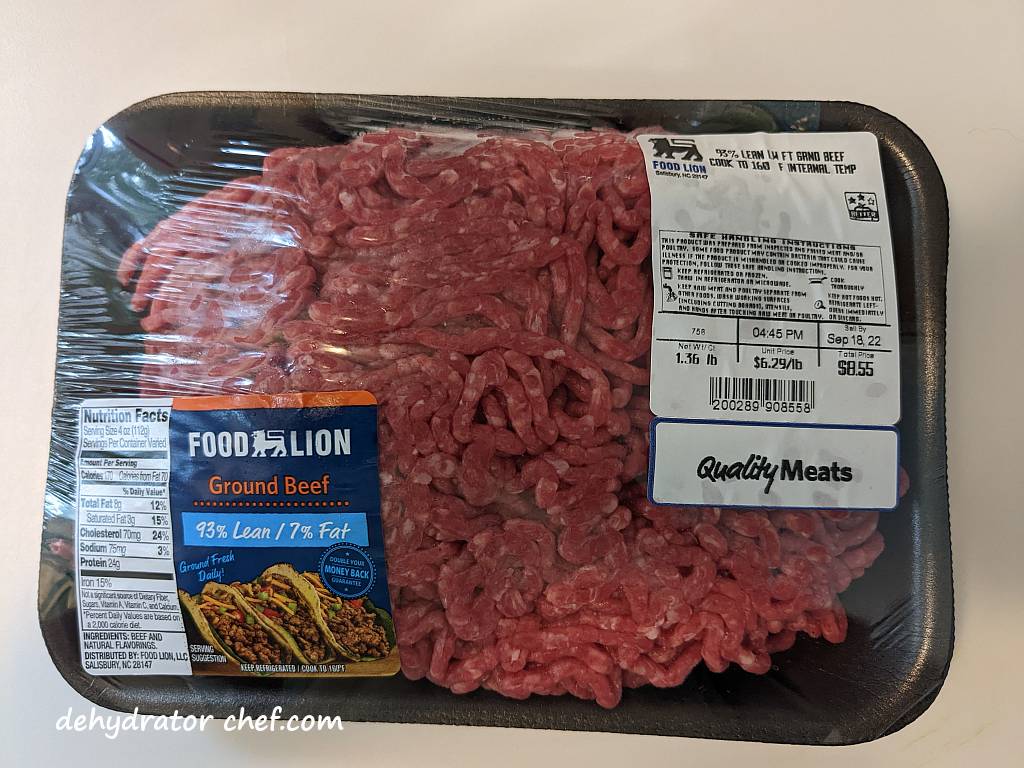
All you need to dehydrate ground beef is a good quality food dehydrator. We use the Nesco FD-61, and you can check out our food dehydrator guide here and why we think Nesco offers the best bang for the buck.
Supplies Needed to Dehydrate Ground Beef
- Food dehydrator
- Removable fruit roll sheet inserts for the dehydrator trays
- Standard kitchen tools, including cutting boards, chef’s knife, spatula, non-stick frying pan, etc.
- Clear canning jars with tight-fitting lids
- Desiccant packets
- Wide-mouth canning jar funnel
- 1 pound lean 93/7 ground beef
- 1/2 cup plain breadcrumbs for every 1 pound of lean ground beef
Step 1. The Process to Dehydrate Ground Beef
Dehydrated ground meat will turn into gravel-like pieces. But we can fix this. Our recipes that use ground meat can be spruced up with just a few ingredient tricks. We will add a panade to our ground meats before dehydration.
When meat is ground into smaller pieces, then cooked and dehydrated, almost all the moisture disappears and affects the texture of the meat. Rehydrating ground meat so it’s edible seems to take forever. Adding a panade will help alleviate this problem keeping the meat tender and flavorful.

A panade is a mix of starch and liquid you would add to the ground meat so it doesn’t get hard or dry when cooked. The starch will also help bring in moisture and hydrate the meat for a better texture in our dehydrated meals.
Any combination of starches, such as bread, bread crumbs, or crackers, will work. Similarly, liquids such as milk, buttermilk, stock, or water can be used. We could also add additional spices if we wanted.
But we’re skipping the liquid and just adding breadcrumbs. The liquid comes later. We are adding 1/2 cup of breadcrumbs to every pound of ground beef.
You can easily make breadcrumbs in your food dehydrator. Dehydrate a few slices of bread or muffins for several hours at 135 °F / 57 °C, then coarsely chop them in a blender or food processor.
In a mixing bowl, break the ground beef into small marble-size pieces. Then sprinkle the breadcrumbs over the top of the meat and mix. Work the breadcrumbs into the meat using your fingers and form it into a ball.
Cover the mixing bowl with plastic wrap and let the meat mixture rest in the refrigerator for at least 30 minutes.
In a skillet over medium heat, cook the ground beef until done and no longer pink. You may want to do this in smaller batches. As it cooks, break the meat apart as it cooks into smaller pieces.
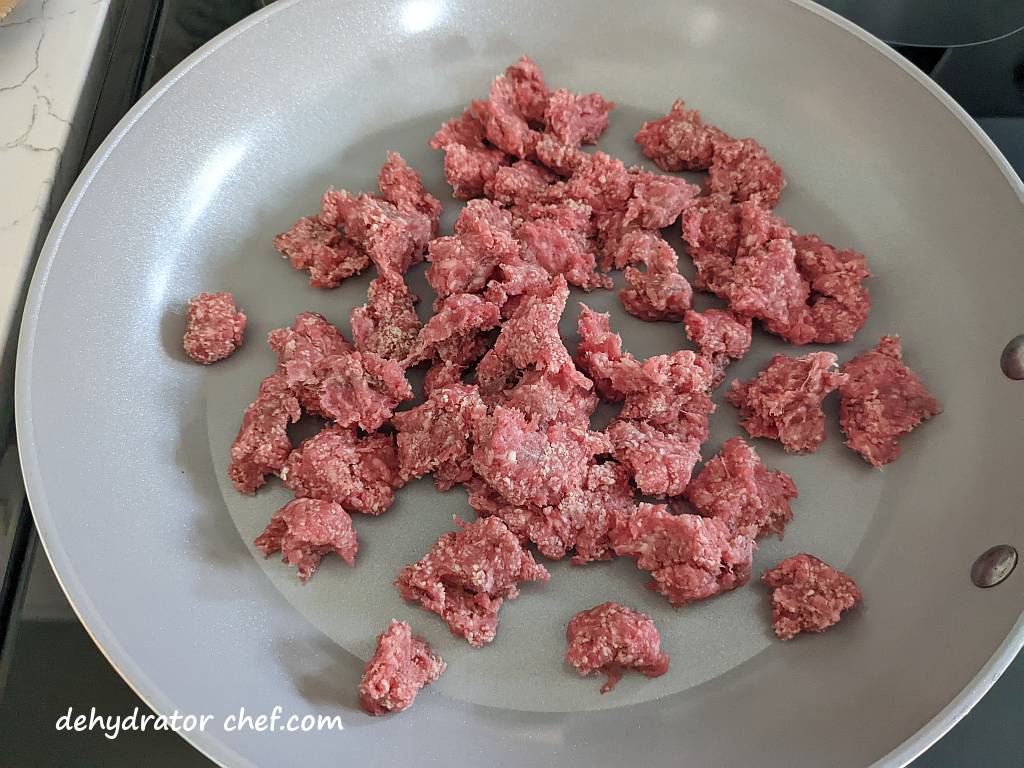
When cooked, take the additional time to chop the cooked ground beef into smaller crumbles on a cutting board. You may notice the cooked ground beef feels a bit gummy or tacky. However, the smaller beef crumbles will hydrate much quicker and yield better results.
Step 2. Preparing the Dehydrator to Dehydrate Ground Beef
We will use these removable Nesco fruit roll sheet inserts on our Nesco FD-61 for dehydrating the ground beef. They have over 3000 customer reviews with an average rating of 4.5 stars out of 5 which is evidence of a great product. Check out other Nesco food dehydrator products here.
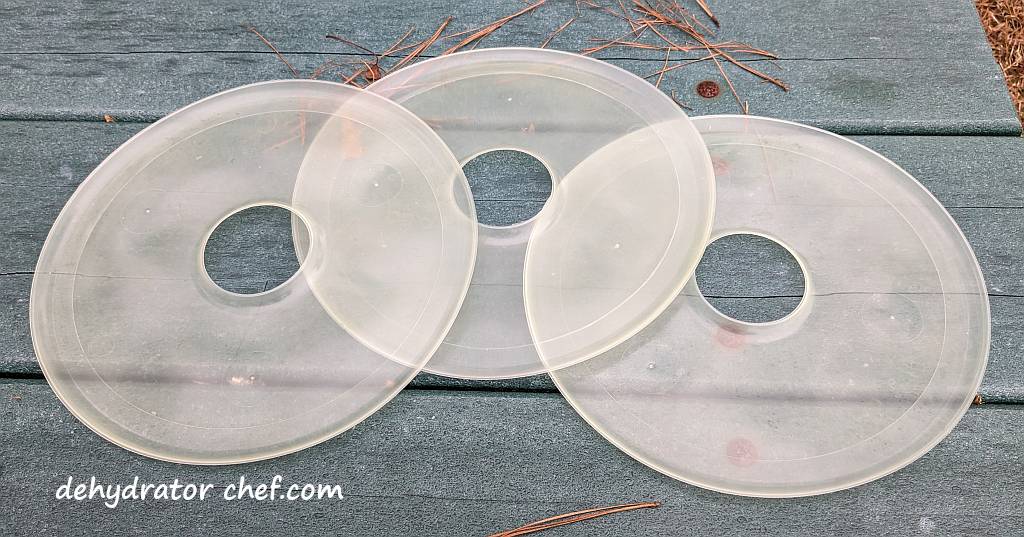
Try to spread a thin layer of beef crumbles on the dehydrator trays for a better outcome and a faster dry time. We average 2 dehydrator trays for every pound of cooked ground beef in our Nesco FD-61.
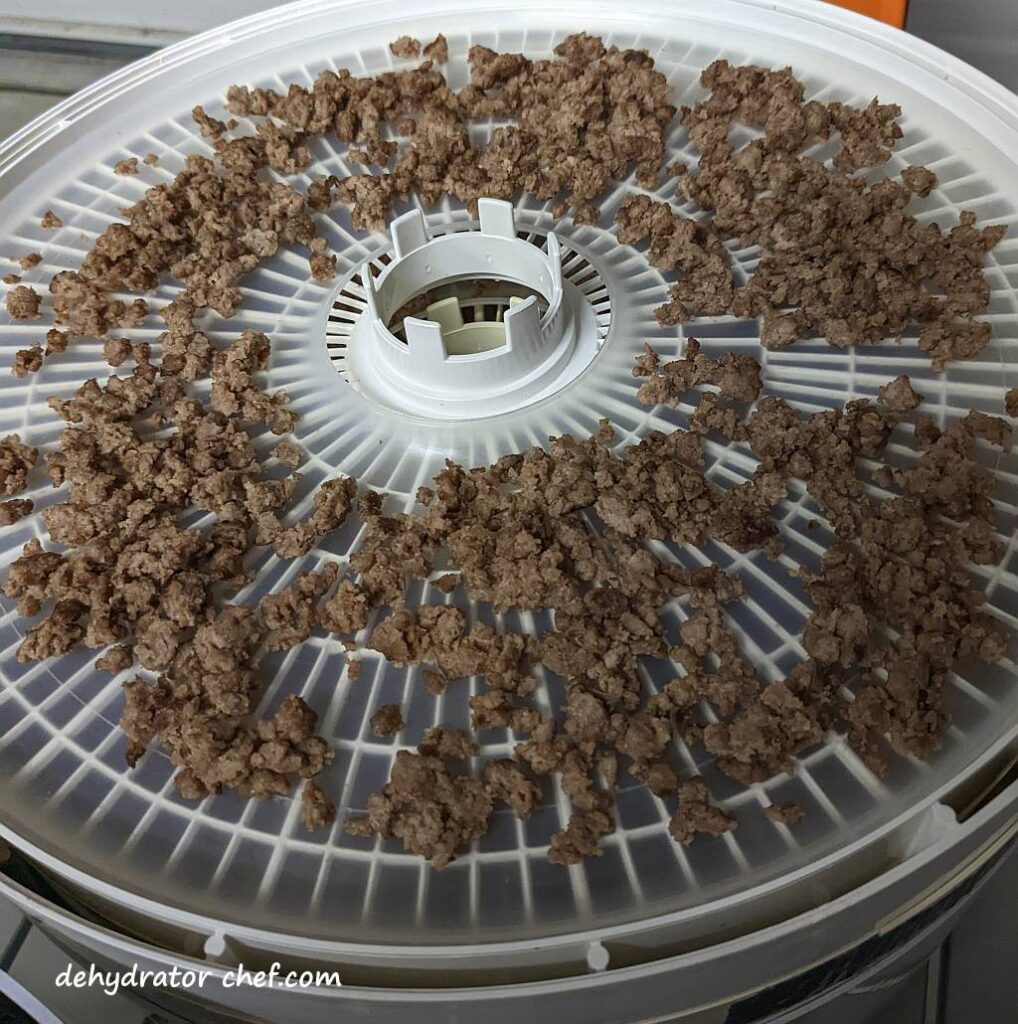
The Nesco 13.5-inch round dehydrator tray has close to 119 square inches or .8 square feet of surface area for drying.
Step 3. Dehydrating Ground Beef
Dehydrate ground beef, just like other meat, at 160 °F / 71 °C until dry. My Nesco FD-61 takes approximately 6 to 8 hours to dehydrate the ground beef depending upon the ambient temperature, humidity, and how crowded you fill your trays. Remember, use drying times as a guide.

You might notice the ground beef is a bit tacky from the panade as it begins to dehydrate.
Step 4. When is the Dehydrated Ground Beef Done
When fully dehydrated, the ground beef crumbles will be hard and dry. There should be no tacky pieces.

Drying times will vary depending on your dehydrator. Refer to your dehydrator owner’s manual for recommended temperatures and times for dehydrating specific foods.
Step 5. Equalizing and Conditioning Dehydrated Ground Beef
We always recommend letting food items cool completely after they have finished dehydrating and before packing them in an airtight storage container. Warm food may cause sweating, providing enough moisture for mold to grow.
It does not take long for dehydrated food items to start hydrating from naturally occurring household humidity. Do not leave dehydrated food items exposed to the elements any longer than necessary because of the increased risk of mold growth.
After a short cooling period, pack the dehydrated ground beef into clean, dry, insect-proof containers. We’ll use pint-size or quart-size mason jars with tight-fitting lids.

When the dehydrated ground beef is removed from the dehydrator, any remaining moisture may not be distributed equally because of the size, location, and position. Equalizing and conditioning is a process for freshly dehydrated foods that ensures any residual moisture remaining in any piece is spread or equalized among all the other pieces in the batch. Let the dehydrated ground beef equalize and condition in the storage container for 7 to 10 days.
A quality stainless steel or plastic canning jar funnel makes the messy job of getting dehydrated foods off the dehydrator tray removable inserts and into the canning jars an easy task. Take a minute or two and check them out on Amazon.
Every day, check the jar for moisture. Roll the jar contents around and note any clumping or sticking. If seen, put the contents back on the dehydrator for several more hours. Since canning jars are clear, it’s easy to see what’s inside.
Step 6. Storing Dehydrated Ground Beef
The storage of home-dehydrated meats is a very controversial subject. Should you use oxygen absorbers or not? What about desiccant packets for moisture control? Vacuum sealing? Freezing? Many websites say no, some say yes, while others are silent on this complex and controversial topic.
I don’t use my dehydrated foods for long-term storage. I rotate through it. Otherwise, I’ll use freeze-dried foods for my long-term food storage needs.
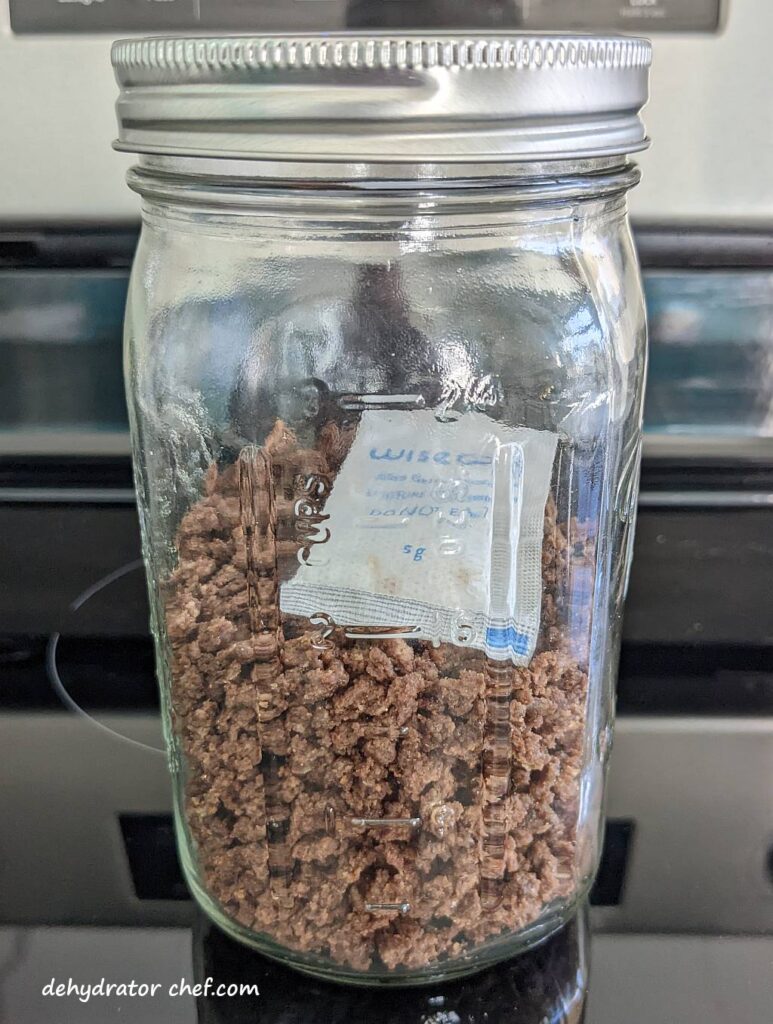
The USDA tells us that drying jerky makes it shelf stable for a short period, 1 to 2 months. We’re not dehydrating jerky. My Nesco food dehydrator manual says the shelf life of dried, cooked meats is 2 to 3 weeks at room temperature. They can be stored for up to 6 months in the freezer. We don’t own any expensive food testing equipment. So we don’t know how long our cooked and dehydrated ground meats remain safe beyond those guidelines, even with the use of desiccant packets, vacuum sealing, freezing, or less-than-ideal pantry storage variables.
Oxygen absorber manufacturers and some dehydrating and prepper websites say that you should not use oxygen absorbers for home dehydrated meats. Because you cannot be sure of the residual moisture content of dehydrated meats, botulism bacteria may grow in meats that exceed a 10 percent moisture content in a low-oxygen environment and start producing toxins.
Regardless of the type of storage container, it must be air-tight. If it’s not airtight, it will eventually allow your foods to soften and degrade more quickly and possibly even develop mold.
For shorter-term storage, up to a week or three, we use mason jars with tight-fitting lids and a desiccant packet for moisture control. Since mason jars are clear, it’s easy to see what’s inside.
We use these inexpensive food-safe desiccant packets available from Amazon. These 5-gram packets have over 5000 of mostly 4- and 5-star customer reviews, with an average of 4.7 stars out of 5. Our bag of 60 desiccant packets will last quite a while because they can be recharged and reused multiple times. Other food-safe sizes are available.

My preferred means of longer-term storage, up to 6 months, for dehydrated ground meats are in vacuum-sealed bags and stashed away in the freezer.
With any of these methods, I’ll attach or include a short note describing the contents and the date the product was dehydrated. The note also lets me know where to go in my dehydrator logbook if I want to make another note or two.
Hydration
This dehydrated ground beef hydrates best in a 1-to-1 ratio of beef crumbles to water. For example, 1/2 cup of dehydrated beef (60 grams) and 1/2 cup of water.
We have used both cold water and hot water to hydrate. However, water brought to a boil and mixed with the dehydrated ground beef seems to work the best.
For our homemade dehydrated camping meals made with dehydrated ground beef, we’ll let the entire meal hydrate with hot water for at least 20 minutes in an insulated cooking pot.
If you’re supplementing a store-bought freeze-dried meal as we do, just add a bit more boiling water to the pouch. Use the same 1-to-1 ratio of dehydrated meat to water.
Weights, Measures, and Serving Sizes
This information is from a recent entry from the notes we keep on most of our food dehydration efforts.
The store label shows we started with 1.36 pounds of 93/7 lean ground beef. Our digital kitchen scale showed we started with 1 pound 6.2 ounces / 628 grams. Adding the breadcrumbs brought our starting weight up to 709 grams.
After cooking the meat in our non-stick skillet in batches, we were left with about 1.34 pounds / 612 grams of ground beef crumbles.
Finally, after nearly 6 hours in the food dehydrator, we had 268 grams of dehydrated ground beef with the breadcrumb panade.
We consider a ground meat serving-size weight to be 4 ounces. So that is roughly 50 grams of dehydrated weight and measured out to be 1/3 cup by volume.
Insider Tips
Besides our Dehydrator Chef recipes, add these dehydrated beef crumbles to your favorite freeze-dried food pouches. Be sure to compensate by adding a bit more water as you prepare your meal.
If you have one, use a non-stick skillet while making this. Lean ground beef and the breadcrumb panade mix might stick to ordinary cookware such as your cast-iron skillet. Be sure to use a mesh-type sink strainer during clean-up, such as one of these, to keep that mess from going down the drain and potentially clogging the kitchen sink.
